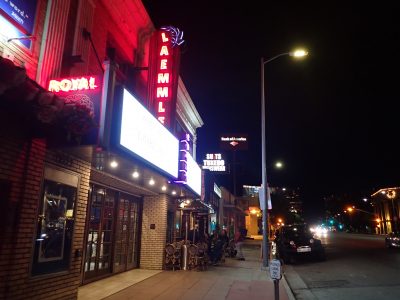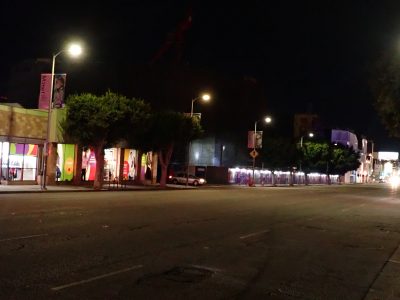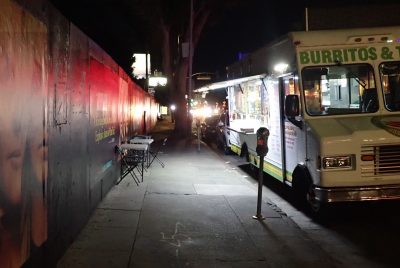Light Over Darkness
New L.A. street lighting design competition spotlights barrier to walking, cycling, and public transit use

A design competition to improve street lighting launched by Mayor Eric Garcetti last week could help Los Angeles meet its climate targets by improving the experience of pedestrians, cyclists, and public transit users on city streets. The competition invites students and design professionals to submit ideas for a new standard L.A. streetlight design, with a winner to be announced in June 2020.
Angelenos’ commitment to cars is one of the city’s most stubborn challenges for reducing greenhouse gas pollution that causes global warming. Increasing the share of zero-emission vehicles on L.A.’s roads is an important part of the solution, but the city cannot reach its climate goals without simultaneously increasing the number of trips L.A. residents take by foot, bicycle, scooter, bus, or other forms of transit.
Like L.A.’s wide boulevards, single-family housing, and drive-thru dry cleaners (and other conveniences), the city’s stock of more than 220,000 street lamps reflects decades of public and private investment in auto-centric infrastructure. Today, L.A.’s street lights tend to illuminate the road rather than sidewalks and bus stops, often leaving pedestrians and transit users invisible to drivers.
“It took us more than half a century to establish the kind of public realm that favors the car,” Christopher Hawthorne, Chief Design Officer for the City of L.A., told Curbed. “We need to be thinking about rebalancing that space.”

Poor street lighting is a significant barrier for Angelenos’ use of bus and rail, especially for women. A recent report from LA Metro on how women travel in L.A. County found that safety on transit was a key concern, and improved lighting was among the top recommendations cited by survey participants to increase a sense of safety when using sidewalks or waiting at transit stops.
Undoing the harm of L.A.’s auto-centric street design will require significant financial investments, but it could also demand more political commitment than policymakers anticipate, even for a cause as seemingly anodyne as improving street lighting.
Angelenos have a long history of resistance to street design shifts and policy changes that de-prioritize drivers. L.A.’s City Council has been embroiled in a tense dispute over a street re-design on Venice Boulevard in Mar Vista to calm traffic speeds and improve safety for pedestrians and cyclists, even prompting threats from angry commuters to sue the city.
In Westwood Village, students opposed changes to parking enforcement that would eliminate “apron parking” that blocks sidewalks and increases risks for pedestrians. And a battle over a bike lane on Westwood Blvd. to connect UCLA and Westwood’s commercial center with nearby rail and bus stops contributed to the dramatic split-up of the local neighborhood advisory council last year.

Upgrading the city’s street lighting to favor pedestrians could even prompt resistance within the city’s environmental community if additional lighting harms habitat or diminishes views of the stars. The city’s design competition brief anticipates these concerns, suggesting that competitors consider moonlight, dark skies, and wildlife in their designs.
Whatever the opposition, improving street lighting is a worthy objective for L.A.’s city leaders. As many parts of Southern California are already experiencing average temperatures more than 2⁰C above pre-industrial times, Los Angeles, a city built for decades around the internal combustion engine needs to rapidly reorient its infrastructure and policies to prioritize every form of fossil-free movement across our urban plane.






Reader Comments